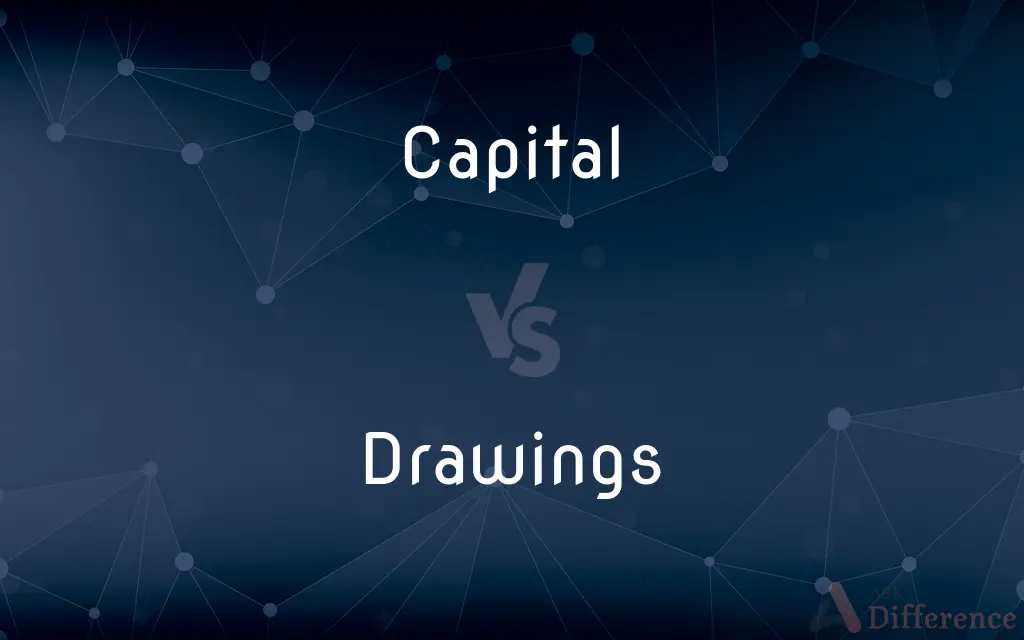Capital vs. Drawings — What's the Difference?
By Tayyaba Rehman — Published on October 12, 2023
Capital is funds invested by owners in a business, while Drawings refer to owners withdrawing funds from the business for personal use.

Difference Between Capital and Drawings
Table of Contents
ADVERTISEMENT
Key Differences
In a business context, Capital refers to the financial resources, either in cash or other assets, that business owners invest in their enterprise. In stark contrast, Drawings signify the money withdrawn by the business owner or the partners from the company's earnings for their personal use. Therefore, capital essentially channels financial resources into the business, while drawings extract them.
Capital is crucial for a business as it provides the necessary financial grounding, enabling the entity to establish, operate, and expand by covering initial costs and sustaining operational expenses. Conversely, Drawings denote the reduction of the owner's equity in the business, as it represents funds being removed, typically for personal use. The dynamic here pivots around infusion versus extraction of financial resources.
The introduction of Capital into a business boosts its financial stability, aids in meeting obligations, and supports potential growth and development endeavors. Drawings, meanwhile, can potentially weaken the business’s financial stability if not managed judiciously since they reduce the capital available within the business. Here, the equilibrium between maintaining adequate operational funds and ensuring the owner can extract earned benefits is vital.
Capital can be subdivided into various categories, such as working capital and fixed capital, each serving different roles within the financial management of the business. On the flip side, Drawings are typically not sub-categorized but might be recorded under varied accounts if extracted for different uses or by different business partners. Thus, while capital can be meticulously managed and allocated for varied business functions, drawings are usually straightforward withdrawals.
An interesting aspect is that Capital is usually introduced with an expectation of return in the form of profit, implying that it is invested with the intent of financial growth. In divergence, Drawings are not bound by an obligation of return to the business, as they are distributions to the owner from the earned profits or capital and therefore diminish the initial investment. Thus, the expectation of return versus the lack thereof brings another layer of differentiation.
ADVERTISEMENT
Comparison Chart
Definition
Money or value invested into the business by the owner(s)
Money withdrawn by the owner(s) for personal use
Impact on Equity
Increases owner’s equity in the business
Decreases owner’s equity in the business
Financial Stability
Enhances financial stability and supports growth
Can potentially weaken financial stability
Sub-categories
Can be categorized (working capital, fixed capital, etc.)
Typically not sub-categorized
Expectation of Return
Introduced with an expectation of generating profit
Withdrawn without an obligation to be returned
Compare with Definitions
Capital
Financial resources invested in a business by its owner(s).
He invested additional Capital to expand the business operations.
Drawings
Money withdrawn by a business owner for personal use.
Her regular Drawings were utilized for home expenditures.
Capital
Wealth in the form of money or assets, used to fund a business.
The entrepreneur secured enough Capital to launch her startup.
Drawings
Funds taken from a business’s profits by the owner.
The accountant recorded monthly Drawings to ensure accurate bookkeeping.
Capital
Financial means invested to facilitate business activities.
The lack of Capital hindered the company's potential growth.
Drawings
The owner’s withdrawal of assets from the company.
Excessive Drawings can potentially hamper the firm's financial stability.
Capital
A town or city that is the official seat of government in a political entity, such as a state or nation.
Drawings
Reduction of owner’s equity by extracting funds from the business.
His Drawings from the business supported his lifestyle.
Capital
A city that is the center of a specific activity or industry
The financial capital of the world.
Drawings
Monetary amounts taken by the proprietor from the business’s capital.
He kept his Drawings minimal to maintain the business’s capital health.
Capital
Wealth, especially in the form of financial or physical assets, used in the production or accumulation of more wealth.
Drawings
The act or an instance of drawing.
Capital
Accumulated assets or advantages used for economic or political gain
"The president lacks the political capital to override their objections" (The Economist).
Drawings
The art of representing objects or forms on a surface chiefly by means of lines.
Capital
The money invested in a corporation, including debt and equity.
Drawings
A work produced by this art.
Capital
Net worth.
Drawings
Plural of drawing
Capital
Capital stock.
Capital
Capitalists considered as a group or class.
Capital
A capital letter.
Capital
The top part of a pillar or column, typically having an ornamental design.
Capital
First and foremost; principal
A decision of capital importance.
Capital
First-rate; excellent
A capital idea.
Capital
Relating to or being a seat of government.
Capital
Extremely serious
A capital blunder.
Capital
Involving death or calling for the death penalty
A capital offense.
Capital
Of or relating to financial assets, especially being or related to those financial assets that add to the net worth of a business
Made capital improvements at the plant site.
Capital
Relating to or being a capital letter.
Capital
Already-produced durable goods available for use as a factor of production, such as steam shovels (equipment) and office buildings (structures).
Capital
Money and wealth. The means to acquire goods and services, especially in a non-barter system.
He does not have enough capital to start a business.
Capital
(countable) A city designated as a legislative seat by the government or some other authority, often the city in which the government is located; otherwise the most important city within a country or a subdivision of it.
Washington D.C. is the capital of the United States of America.
The Welsh government claims that Cardiff is Europe’s youngest capital.
Capital
(countable) The most important city in the field specified.
Capital
(countable) An uppercase letter.
Capital
The uppermost part of a column.
Capital
(uncountable) Knowledge; awareness; proficiency.
Interpreters need a good amount of cultural capital in order to function efficiently in the profession.
Capital
The chief or most important thing.
Capital
Of prime importance.
Capital
Chief, in a political sense, as being the seat of the general government of a state or nation.
London and Paris are capital cities.
Capital
Excellent.
That is a capital idea!
Capital
(crime) Punishable by, or involving punishment by, death.
Capital
Uppercase.
One begins a sentence with a capital letter.
Capital
Used to emphasise greatness or absoluteness
You're a genius with a capital G!
He's dead with a capital D!
Capital
Of or relating to the head.
Capital
Of or pertaining to the head.
Needs must the Serpent now his capital bruiseExpect with mortal pain.
Capital
Having reference to, or involving, the forfeiture of the head or life; affecting life; punishable with death; as, capital trials; capital punishment.
Many crimes that are capital among us.
To put to death a capital offender.
Capital
First in importance; chief; principal.
A capital article in religion
Whatever is capital and essential in Christianity.
Capital
Chief, in a political sense, as being the seat of the general government of a state or nation; as, Washington and Paris are capital cities.
Capital
Of first rate quality; excellent; as, a capital speech or song.
Capital
The head or uppermost member of a column, pilaster, etc. It consists generally of three parts, abacus, bell (or vase), and necking. See these terms, and Column.
Capital
The seat of government; the chief city or town in a country; a metropolis.
Capital
That portion of the produce of industry, which may be directly employed either to support human beings or to assist in production.
Capital
Anything which can be used to increase one's power or influence.
He tried to make capital out of his rival's discomfiture.
Capital
An imaginary line dividing a bastion, ravelin, or other work, into two equal parts.
Capital
A chapter, or section, of a book.
Holy St. Bernard hath said in the 59th capital.
Capital
Assets available for use in the production of further assets
Capital
Wealth in the form of money or property owned by a person or business and human resources of economic value
Capital
A seat of government
Capital
One of the large alphabetic characters used as the first letter in writing or printing proper names and sometimes for emphasis;
Printers once kept the type for capitals and for small letters in separate cases; capitals were kept in the upper half of the type case and so became known as upper-case letters
Capital
A book written by Karl Marx (1867) describing his economic theories
Capital
The upper part of a column that supports the entablature
Capital
First-rate;
A capital fellow
A capital idea
Capital
Punishable by death;
A capital offense
Capital
Of primary important;
Our capital concern was to avoid defeat
Capital
Uppercase;
Capital A
Great A
Many medieval manuscripts are in majuscule script
Capital
Assets employed in generating profit within a business.
Adequate Capital ensured the company navigated through financial crises smoothly.
Capital
Monetary input by owners to establish and sustain a business.
The infusion of Capital enabled the firm to explore new markets.
Common Curiosities
How does Capital influence a business’s financial stability?
Capital enhances a business’s financial stability by providing the necessary funds to meet obligations and support operations and growth.
Can Capital include assets other than cash?
Yes, Capital can include cash, property, equipment, or other assets invested into the business.
What is meant by Capital in a business context?
Capital refers to the financial resources invested by the owner(s) into a business to fund its establishment and operations.
What does Drawings refer to in terms of business finance?
Drawings refer to the funds withdrawn by the owner(s) from the business profits or capital for personal use.
Can Drawings impact a business negatively?
Yes, excessive Drawings can weaken a business's financial stability by reducing the available capital.
How are Drawings recorded in accounting?
Drawings are recorded by decreasing the owner’s equity account and the business’s cash or assets.
Can Capital be increased after the initial investment?
Yes, owners can inject additional Capital into the business post-establishment to support its activities.
Share Your Discovery

Previous Comparison
First Name vs. Family Name
Next Comparison
Personnel Management vs. Human Resource ManagementAuthor Spotlight
Written by
Tayyaba RehmanTayyaba Rehman is a distinguished writer, currently serving as a primary contributor to askdifference.com. As a researcher in semantics and etymology, Tayyaba's passion for the complexity of languages and their distinctions has found a perfect home on the platform. Tayyaba delves into the intricacies of language, distinguishing between commonly confused words and phrases, thereby providing clarity for readers worldwide.














































